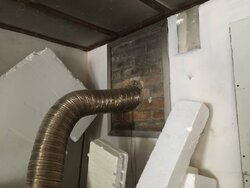hi. My shop had 40 years of burning liner less brick chimney. I think the chimney doesn't touch to much wood in the building attic. Anyways so I an going to put an uninsulated liner down there to improve things. and the guy that sold it tole me to just bend the Liner in threw the hole and out and then connect the black pipe to that, rather than installing a t inside or a pass threw thimble. I don't see any problem with this, I have been using it for about 2 years but am not going to improve things a bit.
Not sure if I should insulate the liner or at a pass threw thimble. It seems expensive and the liner came out clean after two years of burning.
Not sure if I should insulate the liner or at a pass threw thimble. It seems expensive and the liner came out clean after two years of burning.


